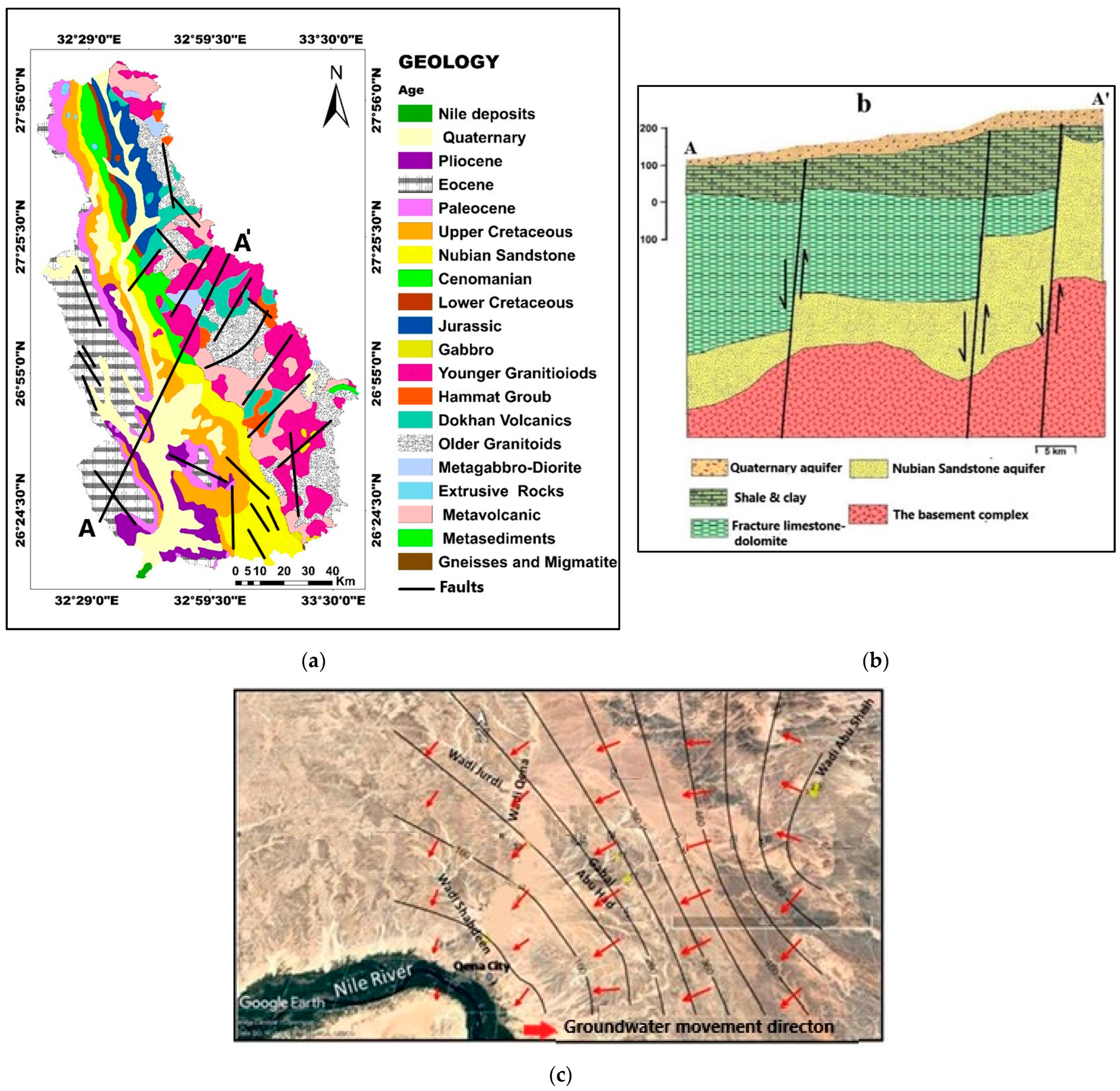Groundwater Recharge Potentiality Mapping in Wadi Qena, Eastern Desert Basins of Egypt for Sustainable Agriculture Base Using Geomatics Approaches
Abstract
:1. Introduction
2. Materials and Methods
2.1. Description of the Study Area
2.2. Geological and Hydrological Setting
2.3. The Approach to Generating Groundwater Recharge Potential Maps
3. Results
3.1. Remote Sensing and GIS to Determine Groundwater Potential Zones
3.2. Lithology/Geological Map
3.3. Drainage Density
3.4. Slope Map
3.5. Topography Map
3.6. Soil Map
3.7. Rainfall Map
3.8. Lineament Map
3.9. Land Use/Land Cover Data (LULC)
3.10. Flow Accumulation
3.11. Flow Direction
3.12. Groundwater Charateristics for Agriculture Use
3.13. Physical Properties of the Groundwater Samples
3.14. Chemical Properties and Composition of the Groundwater
4. Discussion
4.1. Groundwater Prospect Map
4.2. Field Observation
4.3. Soil Studies and Field Survey
5. Conclusions
Author Contributions
Funding
Data Availability Statement
Acknowledgments
Conflicts of Interest
References
- Milewski, A.; Sultan, M.; Yan, E.; Becker, R.; Abdeldayem, A.; Soliman, F.; Gelil, K.A. A remote sensing solution for estimating runoff and recharge in arid environments. J. Hydrol. 2009, 373, 1–14. [Google Scholar] [CrossRef]
- Hussien, H.M.; Kehew, A.E.; Aggour, T.; Korany, E.; Abotalib, A.Z.; Hassanein, A.; Morsy, S. An integrated approach for identification of potential aquifer zones in structurally controlled terrain: Wadi Qena basin, Egypt. Catena 2017, 149, 73–85. [Google Scholar] [CrossRef]
- Voogd, H. Multi-ctiteria evaluation for urban and regional planning, Pion, London. Water Resour. Manag. 1983, 24, 921–939. [Google Scholar]
- Chowdhury, A.; Jha, M.K.; Chowdary, V.M. Delineation of groundwater recharge zones and identification of artificial recharge sites in West Medinipur district, West Bengal, using RS, GIS and MCDM techniques. Environ. Earth Sci. 2010, 59, 1209–1222. [Google Scholar] [CrossRef]
- Meshram, K.S.; Tripathi, M.P.; Mukharjee, A.P. Effect of Artificial Recharge Structures on Ground Water Availability in Semi-critical Area in Chhattisgarh. Doctoral Dissertation, Indira Gandhi KrishiVishwavidyalaya, Purena, India, 2010; pp. 4–23. [Google Scholar]
- Samson, S.; Elangovan, K. Delineation of groundwater recharge potential zones in Namakkal District, Tamilnadu, India using remote sensing and GIS. J. Indian Soc. Remote Sens. 2015, 43, 769–778. [Google Scholar] [CrossRef]
- Eastman, J.R. Multi-Criteria Evaluation and Geographical Information Systems; Longley, P.A., Goodchild, M.F., Magurie, D.J., Rhind, D.W., Eds.; John Wiley and Sons: New York, NY, USA, 1996; Volume 1, pp. 493–502. [Google Scholar]
- Taheri, A.; Zare, M. Groundwater artificial recharge assessment in Kangavar Basin, a semi-arid region in the western part of Iran. Afr. J. Agric. Res. 2011, 6, 4370–4384. [Google Scholar]
- Das, B.; Pal, S.C. Assessment of groundwater recharge and its potential zone identification in groundwater-stressed Goghat-I block of Hugli District, West Bengal, India. Environ. Dev. Sustain. 2020, 22, 5905–5923. [Google Scholar] [CrossRef]
- ElKashouty, M. Watershed delineation and morphometric analysis using remote sensing and GIS mapping techniques in Qena-Safaga-Bir Queh, Central Eastern Desert. Int. J. Water Resour. Environ. Eng. 2020, 12, 22–46. [Google Scholar] [CrossRef]
- Deepika, B.; Avinash, K.; Jayappa, K.S. Integration of hydrological factors and demarcation of groundwater prospect zones: Insights from remote sensing and GIS techniques. Environ. Earth Sci. 2013, 70, 1319–1338. [Google Scholar] [CrossRef]
- Deepa, S.; Venkateswaran, S.; Ayyandurai, R.; Kannan, R.; Vijay Prabhu, M. Groundwater recharge potential zones mapping in upper Manimuktha Sub basin Vellar river Tamil Nadu India using GIS and remote sensing techniques. Model. Earth Syst. Environ. 2016, 2, 137. [Google Scholar] [CrossRef]
- Machiwal, D.; Rangi, N.; Sharma, A. Integrated knowledge-and data-driven approaches for groundwater potential zoning using GIS and multi-criteria decision-making techniques on hard-rock terrain of Ahar catchment, Rajasthan, India. Environ. Earth Sci. 2015, 73, 1871–1892. [Google Scholar] [CrossRef]
- Ait El Mekki, O.; Laftouhi, N.E. Combination of a geographical information system and remote sensing data to map groundwater recharge potential in arid to semi-arid areas: The Haouz Plain, Morocco. Earth Sci. Inform. 2016, 9, 465–479. [Google Scholar] [CrossRef]
- Araffa, S.A.S.; Hamed, H.G.; Nayef, A.; Sabet, H.S.; AbuBakr, M.M.; Mebed, M.E. Assessment of groundwater aquifer using geophysical and remote sensing data on the area of Central Sinai, Egypt. Sci. Rep. 2023, 13, 18245. [Google Scholar] [CrossRef]
- Fauzia; Surinaidu, L.; Rahman, A.; Ahmed, S. Distributed groundwater recharge potentials assessment based on GIS model and its dynamics in the crystalline rocks of South India. Sci. Rep. 2021, 11, 11772. [Google Scholar] [CrossRef]
- Mohieldeen, Y.E.; Elobaid, E.A.; Abdalla, R. GIS-based framework for artificial aquifer recharge to secure sustainable strategic water reserves in Qatar arid environment peninsula. Sci. Rep. 2021, 11, 18184. [Google Scholar] [CrossRef]
- Arulbalaji, P.; Padmalal, D.; Sreelash, K. GIS and AHP Techniques Based Delineation of Groundwater Potential Zones: A case study from Southern Western Ghats, India. Sci. Rep. 2019, 9, 2082. [Google Scholar] [CrossRef]
- Nair, A.R.; Suresh, A.; Saju, A.; Sankar, G.; Achison, R.J. Identification of Groundwater Recharge Potential Zones and Groundwater Quality Mapping Using Remote Sensing and GIS. In Lecture Notes in Civil Engineering, Proceedings of SECON’21, SECON 2021, 12–15 May 2021, Angamali, India; Marano, G.C., Ray Chaudhuri, S., Unni Kartha, G., Kavitha, P.E., Prasad, R., Achison, R.J., Eds.; Springer: Cham, Switzerland, 2022; Volume 171, p. 171. [Google Scholar] [CrossRef]
- Conicelli, b.; Hirata, r.; Galvão, P.; Bernardino, M.; Simonato, M.; Abreu, M.C.; Aranda, N.; Terada, R. Determining groundwater availability and aquifer recharge using GIS in a highly urbanized watershed. J. S. Am. Earth Sci. 2021, 106, 103093. [Google Scholar] [CrossRef]
- Mezni, I.; Chihi, H.; Hammami, M.A.; Gabtni, J.; Sy, M.S. Regionalization of Natural Recharge Zones Using Analytical Hierarchy Process in an Arid Hydrologic Basin: A Contribution for Managed Aquifer Recharge. Nat. Resour. Res. 2022, 31, 867–895. [Google Scholar] [CrossRef]
- Khan, M.Y.A.; ElKashouty, M.; Tian, F. Mapping groundwater potential zones using analytical hierarchical process and multicriteria evaluation in the Central Eastern Desert, Egypt. Water 2022, 14, 1041. [Google Scholar] [CrossRef]
- Khan, M.Y.A.; ElKashouty, M.; Subyani, A.M.; Tian, F.; Gusti, W. GIS and RS intelligence in delineating the groundwater potential zones in Arid Regions: A case study of southern Aseer, southwestern Saudi Arabia. Appl. Water Sci. 2022, 12, 3. [Google Scholar] [CrossRef]
- Pradhan, R.M.; Guru, B.; Pradhan, B.; Biswal, T.K. Integrated multi-criteria analysis for groundwater potential mapping in Precambrian hard rock terranes (North Gujarat), India. Hydrol. Sci. J. 2021, 66, 961–978. [Google Scholar] [CrossRef]
- Roy, S.; Hazra, S.; Chanda, A.; Das, S. Assessment of groundwater potential zones using multi-criteria decision-making technique: A micro-level case study from red and lateritic zone (RLZ) of West Bengal, India. Sustain. Water Res. Manag. 2020, 6, 1–14. [Google Scholar] [CrossRef]
- Jothibasu, A.; Anbazhagan, S. Modeling groundwater probability index in Ponnaiyar River basin of South India using analytic hierarchy process. Model. Earth Syst. Environ. 2016, 2, 109. [Google Scholar] [CrossRef]
- Amer, R.; Sultan, M.; Ripperdan, R.; Ghulam, A.; Kusky, T. An integrated approach for groundwater potential zoning in shallow fracture zone aquifers. Int. J. Remote Sens. 2013, 34, 6539–6561. [Google Scholar] [CrossRef]
- Rashed, M.; Idris, Y.; Shaban, M. Integrative approach of GIS and remote sensing to represent the hydrological and hydrochemical conditions of Wadi Qena-Egypt. In Proceedings of the 2nd International Conference on Water Resources and Arid Environment, Research Institute for Groundwater, National Water Research Center, Cairo, Egypt, 26–29 November 2006. [Google Scholar]
- Adiat, K.A.N.; Nawawi, M.N.M.; Abdullah, K. Assessing the accuracy of GIS-based elementary multi-criteria decision analysis as a spatial prediction tool—A case of predicting potential zones of sustainable groundwater resources. J. Hydrol. 2012, 440, 75–89. [Google Scholar] [CrossRef]
- Baghel, S.; Tripathi, M.P.; Khalkho, D.; Al-Ansari, M.; Kumar, A.; Ahmed Elbeltagi, A. Delineation of suitable sites for groundwater recharge based on groundwater potential with RS, GIS, and AHP approach for Mand catchment of Mahanadi Basin. Sci. Rep. 2023, 13, 9860. [Google Scholar] [CrossRef]
- Derdour, A.; Bouanani, A.; Kaid, N.; Mukdasai, K.; Algelany, A.M.; Ahmad, H.; Menni, Y.; Ameur, H. Groundwater Potentiality Assessment of Ain Sefra Region in Upper Wadi Namous Basin, Algeria Using Integrated Geospatial Approaches. Sustainability 2022, 14, 4450. [Google Scholar] [CrossRef]
- Abdekareem, M.; Al-Arifi, N.; Abdalla, F.; Mansour, A.; El-Baz, F. Fusion of Remote Sensing Data Using GIS-Based AHP-Weighted Overlay Techniques for Groundwater Sustainability in Arid Regions. Sustainability 2022, 14, 7871. [Google Scholar] [CrossRef]
- Makonyo, M.; Msabi, M.M. Identification of groundwater potential recharge zones using GIS-based multi-criteria decision analysis: A case study of semi-arid midlands Manyara fractured aquifer, North-Eastern Tanzania. Remote Sens. Appl. Soc. Environ. 2021, 23, 100544. [Google Scholar] [CrossRef]
- Saaty, T.L. The Analytic Hierarchy Process: Planning, Priority Setting, Resources Allocation; McGraw: New York, NY, USA, 1980. [Google Scholar]
- Gheith, H.; Sultan, M. Construction of a hydrologic model for estimating Wadi runoff and groundwater recharge in the Eastern Desert, Egypt. J. Hydrol. 2002, 263, 36–55. [Google Scholar] [CrossRef]
- Abdelkareem, M.; El-Baz, F.; Askalany, M.; Akawy, A.; Ghoneim, E. Groundwater prospect map of Egypt’s Qena Valley using data fusion. Int. J. Image Data Fusion 2012, 3, 169–189. [Google Scholar] [CrossRef]
- Abdel Moneim, A.A. Hydrogeological conditions and aquifers potentiality for sustainable development of the desert areas in Wadi Qena, Eastern Desert, Egypt. Arab. J. Geosci. 2014, 7, 4573–4591. [Google Scholar] [CrossRef]
- Abdel Moneim, A.A.; Seleem, E.M.; Zeid, S.A.; Abdel Samie, S.G.; Zaki, S.; Abu El-Fotoh, A. Hydrogeochemical characteristics and age dating of groundwater in the Quaternary and Nubian aquifer systems in Wadi Qena, Eastern Desert, Egypt. Sustain. Water Resour. Manag. 2015, 1, 213–232. [Google Scholar] [CrossRef]
- Abd El_Hameed, A.G.; El-Shayeb, H.M.; El-Araby, N.A.; Hegab, M.G. Integrated geoelectrical and hydrogeological studies on Wadi Qena, Egypt. NRIAG J. Astron. Geophys. 2017, 6, 218–229. [Google Scholar] [CrossRef]
- Moubark, K.; Abdelkareem, M. Characterization and assessment of groundwater resources using hydrogeochemical analysis, GIS, and field data in southern Wadi Qena, Egypt. Arab. J. Geosci. 2018, 11, 598. [Google Scholar] [CrossRef]
- AbdelRahman, M.A.E.; Arafat, S.M. An Approach of Agricultural Courses for Soil Conservation Based on Crop Soil Suitability Using Geomatics. Earth Syst. Environ. 2020, 4, 273–285. [Google Scholar] [CrossRef]
- AbdelRahman, M.A.E.; Zakarya, Y.M.; Metwaly, M.M.; Koubouris, G. Deciphering Soil Spatial Variability through Geostatistics and Interpolation Techniques. Sustainability 2021, 13, 194. [Google Scholar] [CrossRef]
- AbdelRahman, M.A.E.; Shalaby, A.; Essa, E.F. Quantitative land evaluation based on fuzzy-multi-criteria spatial model for sustainable land-use planning. Model. Earth Syst. Environ. 2018, 4, 1341–1353. [Google Scholar] [CrossRef]
- AbdelRahman, M.A.E. Chapter 17—Remote Sensing and Geographic Information System for Soil Analysis—Vulnerability Mapping and Assessment. In Earth Observation, Geoinformatics for Geosciences; Stathopoulos, N., Tsatsaris, A., Kalogeropoulos, K., Eds.; Elsevier: Amsterdam, The Netherlands, 2023; pp. 309–324. ISBN 9780323989831. [Google Scholar] [CrossRef]
- Belal, A.B.A.; Mohamed, E.S.S.; Abdellatif, M.A.; AbdelRahman, M.A.E. Soil Conditions of Dakhla Oasis, Western Desert, Egypt. In Sustainable Water Solutions in the Western Desert, Egypt: Dakhla Oasis; Iwasaki, E., Negm, A.M., Elbeih, S.F., Eds.; Earth and Environmental Sciences Library; Springer: Cham, Switzerland, 2021. [Google Scholar] [CrossRef]
- AbdelRahman, M.A.E.; Saleh, A.M.; Arafat, S.M. Assessment of land suitability using a soil-indicator-based approach in a geomatics environment. Sci. Rep. 2022, 12, 18113. [Google Scholar] [CrossRef]
- AbdelRahman, M.A.E.; Engel, B.; Eid, M.S.M.; Aboelsoud, H.M. A new index to assess soil sustainability based on Temporal Changes of Soil Measurements Using Geomatics—An example from El-Sharkia, Egypt. All Earth 2022, 34, 147–166. [Google Scholar] [CrossRef]
- AbdelRahman, M.A.E.; Metwaly, M.M.; Afifi, A.A.; D’Antonio, P.; Scopa, A. Assessment of Soil Fertility Status under Soil Degradation Rate Using Geomatics in West Nile Delta. Land 2022, 11, 1256. [Google Scholar] [CrossRef]
- AbdelRahman, M.A.E.; Gad, A.A.; Zaky, A.H. Assessment of Desertification Sensitivity Using Interdisciplinary Multi-criteria in GIS-AHP Environment. In Springer Proceedings in Earth and Environmental Sciences, Proceedings of the ICRSSSA 2022: Applications of Remote Sensing and GIS Based on an Innovative Vision, Hurghada, Egypt, 8–11 December 2022; Gad, A.A., Elfiky, D., Negm, A., Elbeih, S., Eds.; Springer: Cham, Switzerland, 2023. [Google Scholar] [CrossRef]
- Cousin, I.; Buis, S.; Lagacherie, P.; Doussan, C.; Le Bas, C.; Guérif, M. Available water capacity from a multidisciplinary and multiscale viewpoint. A review. Agron. Sustain. Dev. 2022, 42, 46. [Google Scholar] [CrossRef]
- Elbana, M.; Refaie, K.M.; El-Shirbeny, M.A.; AbdelRahman, M.A.E.; Abdellatif, B.; El-Gendy, R.; Attia, W. Indirect estimation of deep percolation using soil water balance equation and NASA Land Simulation Model (LIS) for more sustainable water management. Egypt. J. Soil. Sci. 2019, 59, 363–383. [Google Scholar] [CrossRef]
- Zeitoun, R.; Vandergeest, M.; Vasava, H.B.; Machado, P.V.F.; Jordan, S.; Parkin, G.; Wagner-Riddle, C.; Biswas, A. In-Situ Estimation of Soil Water Retention Curve in Silt Loam and Loamy Sand Soils at Different Soil Depths. Sensors 2021, 21, 447. [Google Scholar] [CrossRef]
- Said, R. Tectonic framework of Egypt. In The Geology of Egypt; Elsevier: Amsterdam, The Netherlands, 1962; pp. 28–44. [Google Scholar]
- Said, R. The Geology of Egypt; Balkema, A.A., Ed.; Rotterdam/Brookfield: Rotterdam, The Netherlands, 1990; p. 734. [Google Scholar] [CrossRef]
- Said, R. The Geological Evolution of the River Nile; Springer Science & Business Media: New York, NY, USA, 2012; p. 151. [Google Scholar]
- Issawi, B.; Jux, U. Contributions to the Stratigraphy of the Paleozoic Rocks in Egypt; Smithsonian Libraries: Cairo, Egypt, 1982; p. 28. [Google Scholar]
- El-Hassanin, A.S.; Oklahoma State University, Stillwater, OK, USA. Personal communication, 1983.
- Hendriks, F.; Luger, P.; Bowitz, J.; Kallenbach, H. Evolution of depositional environments of SE-Egypt during the Cretaceous and lower Tertiary. Berliner geowiss. Abh. 1987, 75, 49–82. [Google Scholar]
- Bandel, K.; Kuss, J.; Malchus, N. The sediments of Wadi Qena (Eastern Desert, Egypt). J. Afr. Earth Sci. (1983) 1987, 6, 427–455. [Google Scholar] [CrossRef]
- El-Shamy, E. Recent recharge and flash flooding opportunities in the Eastern Desert, Egypt; Possibilités de recharge de nappes et de crues subites dans le Désert Oriental, Egypte. Ann. Geol. Surv. Egypt 1992, 18, 323. [Google Scholar]
- Soliman, M.F. Mineralogical, Geochemical, and Stratigraphical Investigations on the Cretaceous/Tertiary (K/T) Boundary Sediments of the Nile Valley, Red Sea Coast, and Western Desert, Egypt. Ph.D. Thesis, Ruprecht-Karls-Üniversität Heidelberg, Heidelberg, Germany, 1998; p. 32. [Google Scholar]
- Klitzsch, E.H.; Squyres, C.H. Paleozoic and Mesozoic geological history of northeastern Africa based upon new interpretation of Nubian strata. AAPG Bull. 1990, 74, 1203–1211. [Google Scholar] [CrossRef]
- EGSMA. Geological Map of Egypt, Scale 1: 2,000,000; The Egyptian Geological Survey and Mineral Authority: Cairo, Egypt, 1981. [Google Scholar]
- Conoco. Geologic Map of Egypt; Egyptian General Authority for Petroleum (UNESCO Joint Map Project), 20 Sheets, Scale 1:500 000; Conoco: Cairo, Egypt, 1987. [Google Scholar]
- Thakur, J.K.; Singh, S.K.; Ekanthalu, V.S. Integrating remote sensing, geographic information systems and global positioning system techniques with hydrological modeling. Appl Water Sci. 2017, 7, 1595–1608. [Google Scholar] [CrossRef]
- Eastern Desert Project (EDP). Developing Renewable Ground Water Resources in Arid Lands Pilot Case: The Eastern Desert of Egypt, Local Assessment and Field Verification for “Wadi Qena”; Final Report; Eastern Desert Project (EDP), 2006; 220p, Available online: https://iwlearn.net/documents/6624 (accessed on 2 October 2023).
- UNESCO. Geological Map of the Western Desert; Cooperation with UNDP, EGY/97/011; UNESCO Cairo Office: Cairo, Egypt, 2005. [Google Scholar]
- Shaban, A.; Khawlie, M.; Abdallah, C. Use of remote sensing and GIS to determine recharge potential zones: The case of Occidental Lebanon. Hydrogeol. J. 2006, 14, 433–443. [Google Scholar] [CrossRef]
- Morgan, H.; Hussien, H.M.; Madani, A.; Nassar, T. Delineating Groundwater Potential Zones in Hyper-Arid Regions Using the Applications of Remote Sensing and GIS Modeling in the Eastern Desert, Egypt. Sustainability 2022, 14, 16942. [Google Scholar] [CrossRef]
- Abdalla, F. Mapping of groundwater prospective zones using remote sensing and GIS techniques: A case study from the Central Eastern Desert, Egypt. J. Afr. Earth Sci. 2012, 70, 8–17. [Google Scholar] [CrossRef]
- Moursy, A.R.A.; Abd El-Galil, A.; Ibrahim, M.; Abd El-hady, A.A.; Mhalla, B. Characterization and classification of soils of Wadi Qena, Eastern Desert, Egypt. Indian J. Agric. Sci. 2020, 90, 1544–1554. [Google Scholar] [CrossRef]
- Ibrahim, M.M.; Wahab, M.A.; Ali, R.R.; El-Baroudy, A.A.; Hussein, A.A. Physiographic and soil mapping of Qena and El-Qarn Wadis by using remote sensing and GIS. Egypt. J. Soil Sci. 2017, 57, 137–141. [Google Scholar]
- Attia, M.K.K.; Gameh, M.A.; El-Desoky, M.A.; Abd El-Aziz, S.H. Land Capability of the Middle Part of Wadi Qena, Eastern Desert, Egypt and Its Suitability for Growing Crops. Assiut J. Agric. Sci. 2021, 52, 100–119. [Google Scholar] [CrossRef]
- Belal, A.A.; Moghanm, F.S.; Mohamed, E.E. Evaluation of some Agricultural Expansion Areas in the Eastern Desert of Egypt using GIS. Egypt. J. Soil Sci. 2014, 54, 209–227. [Google Scholar] [CrossRef]
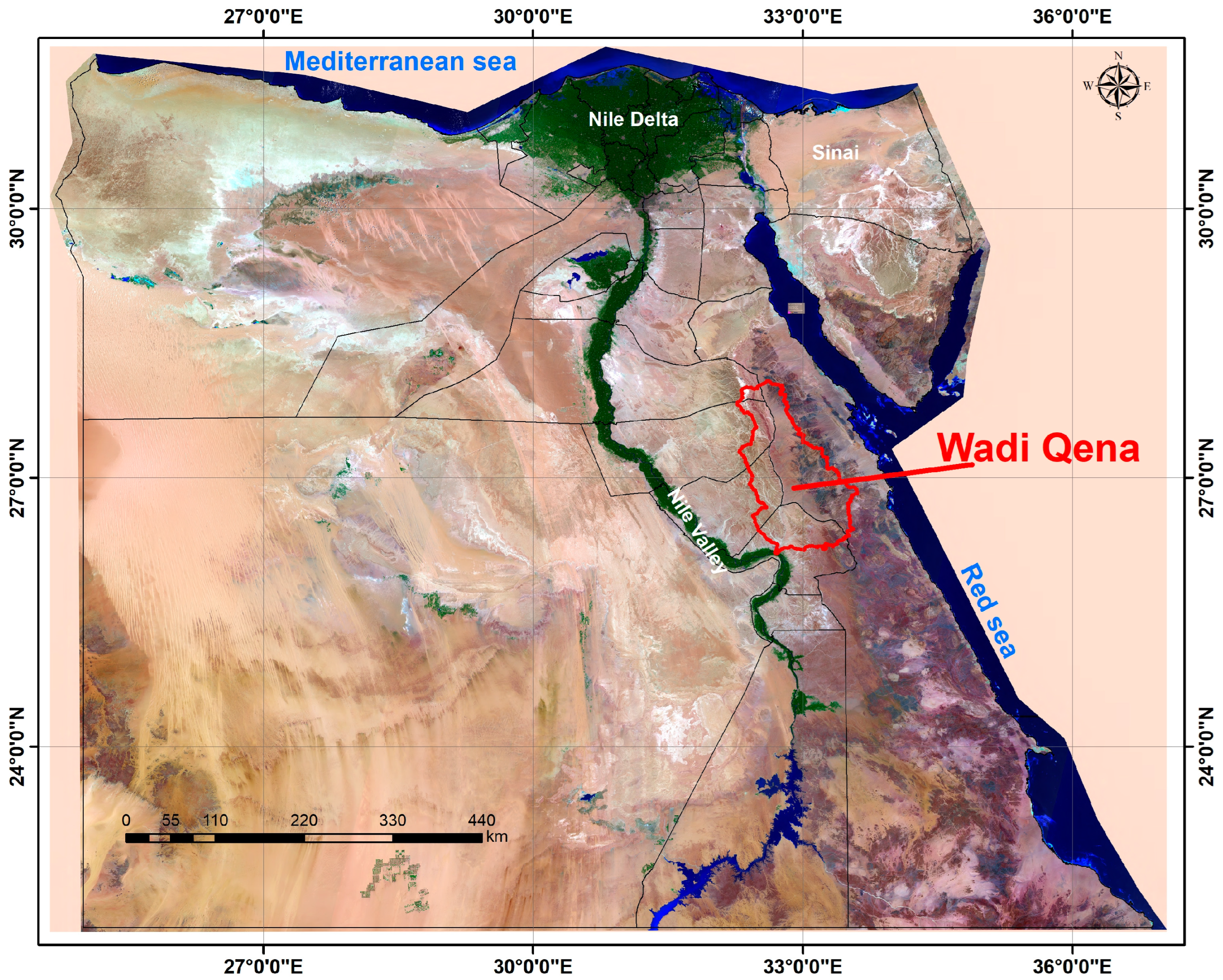
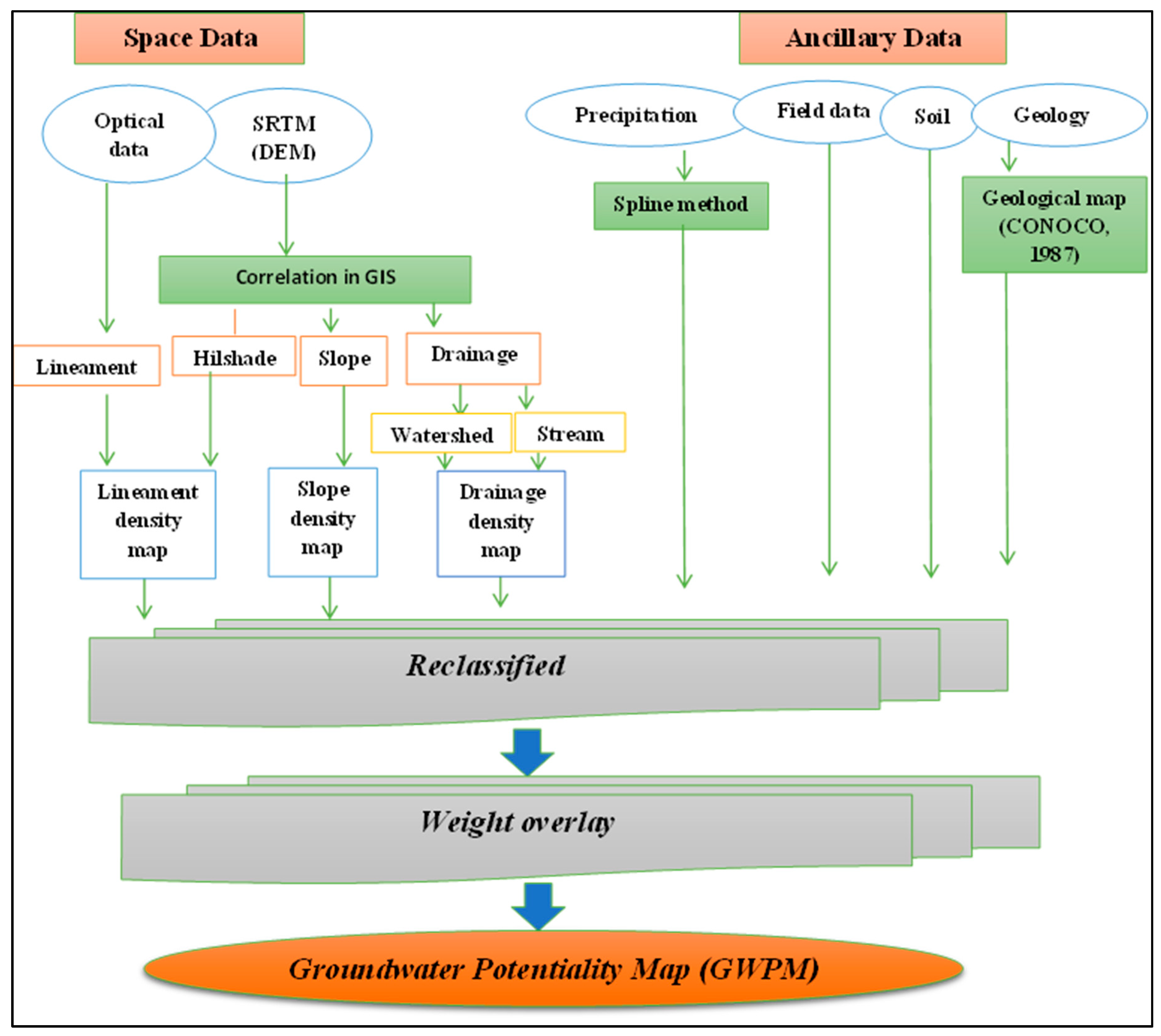
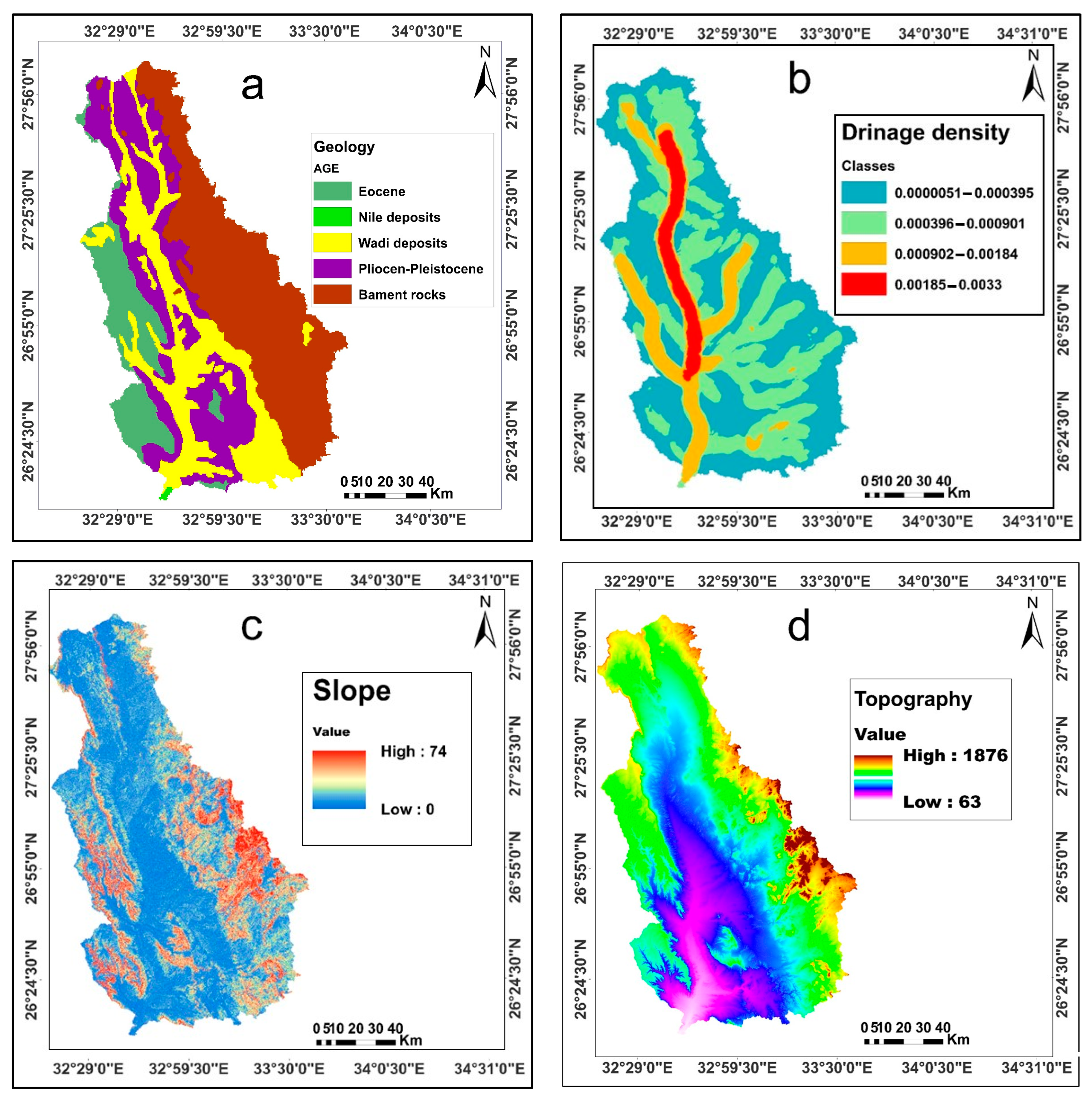
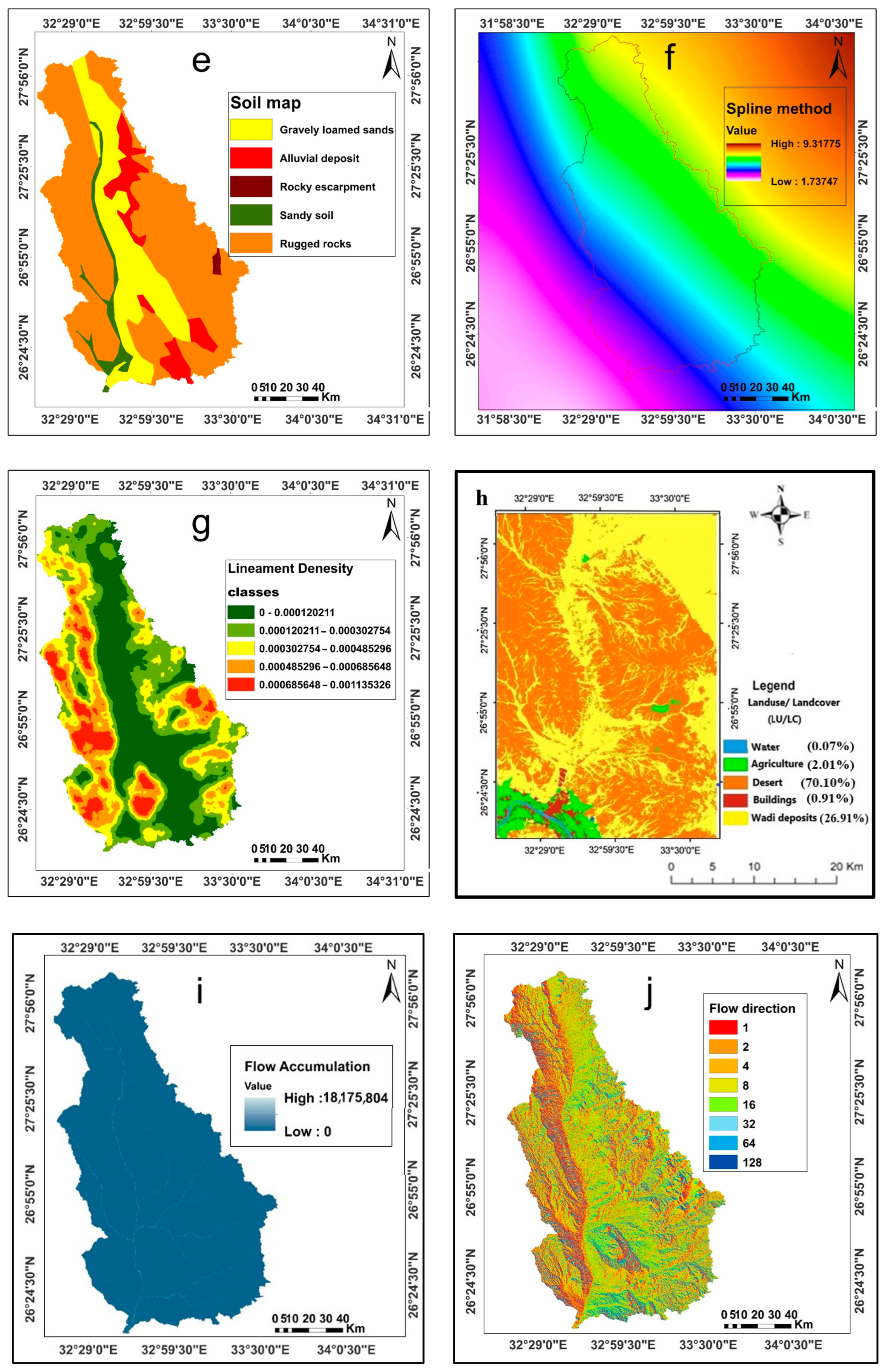
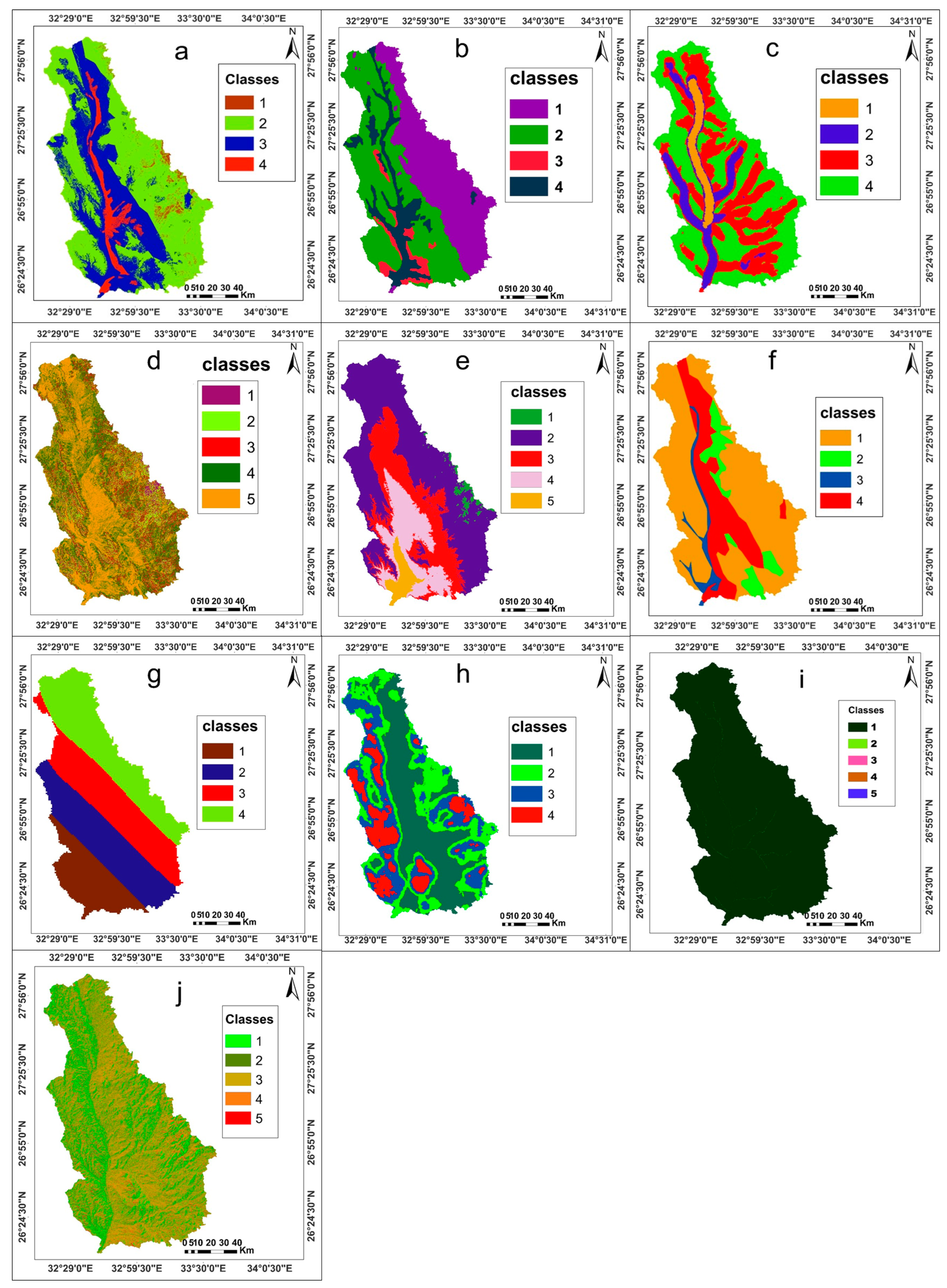
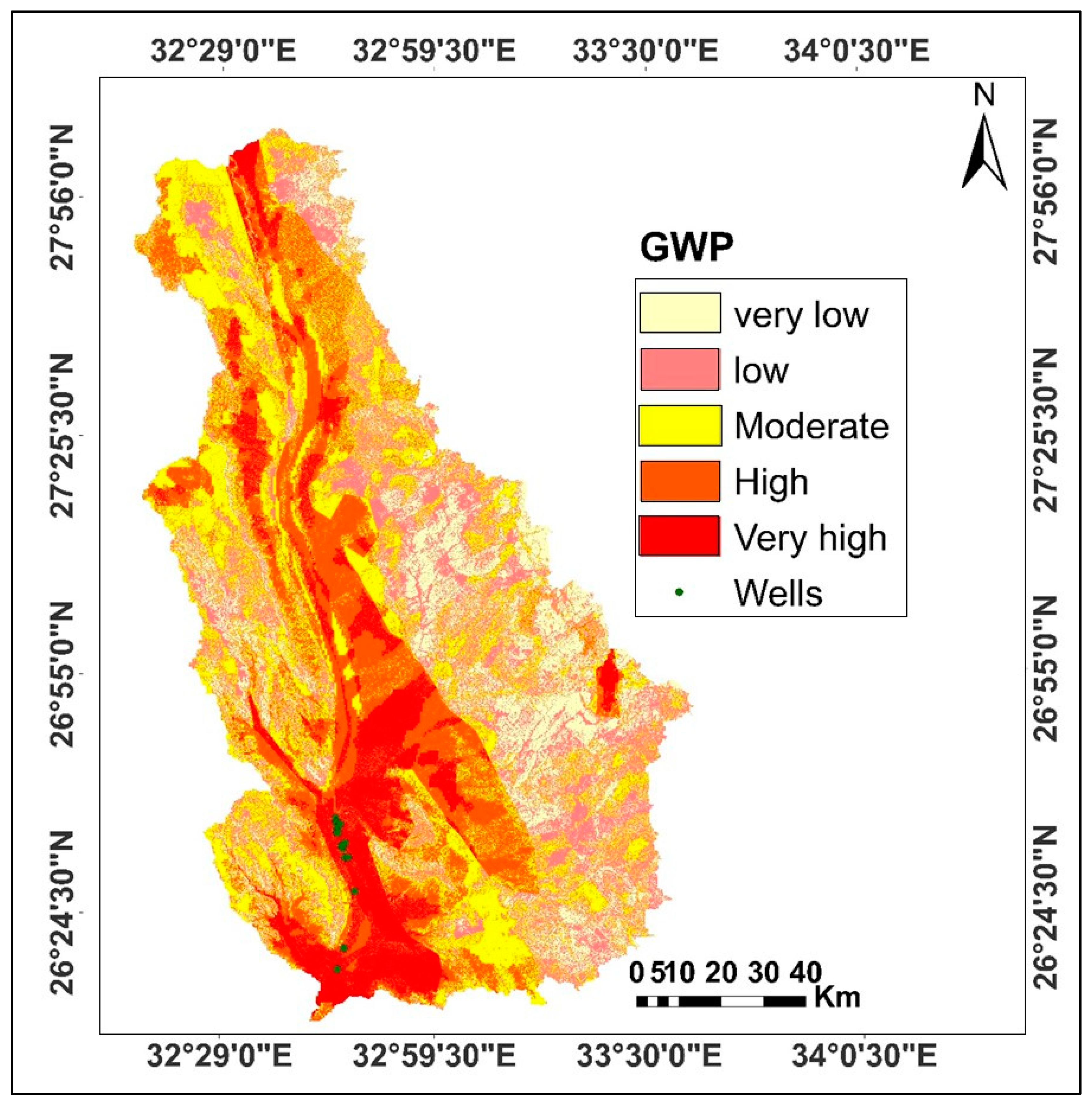
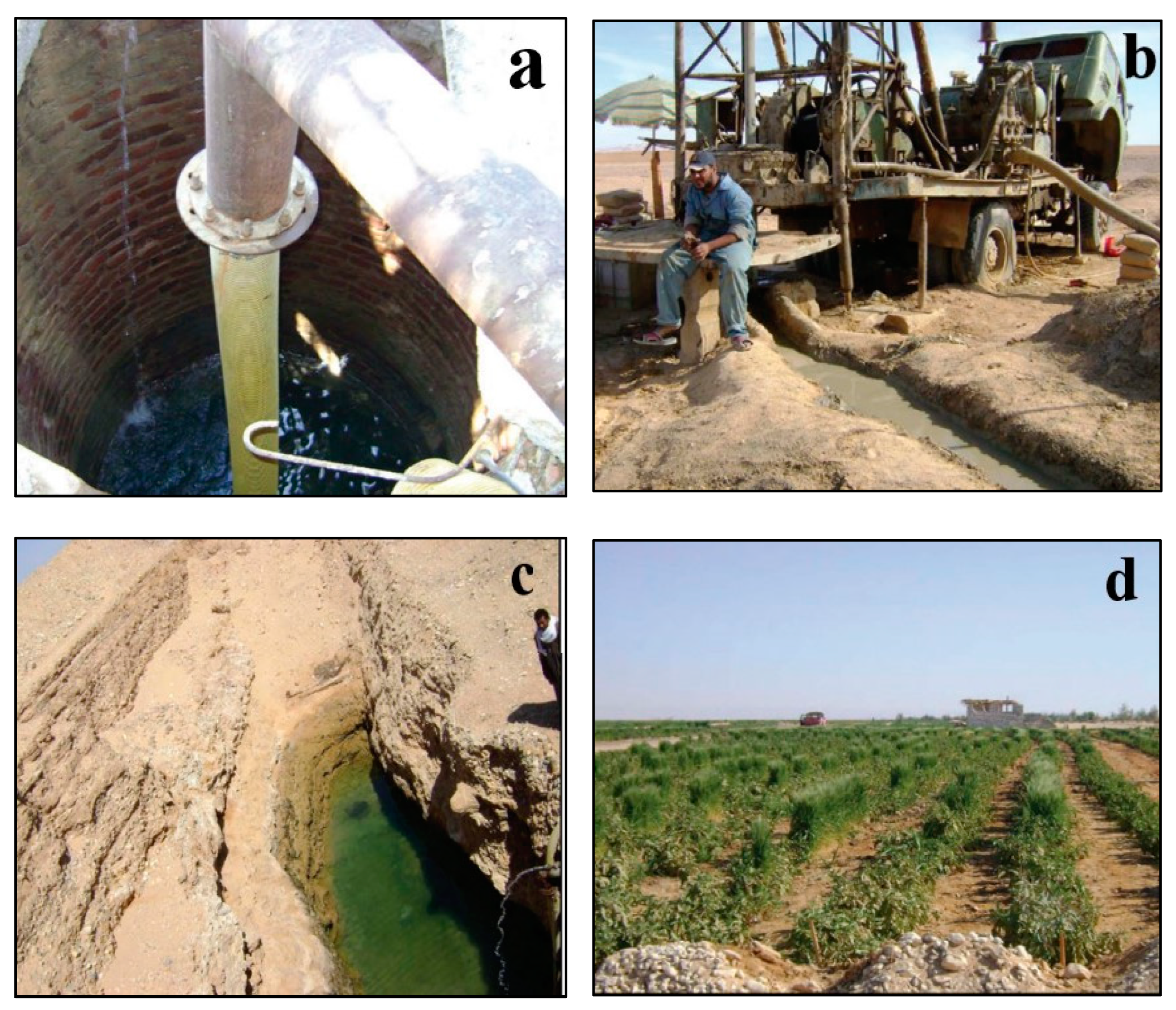
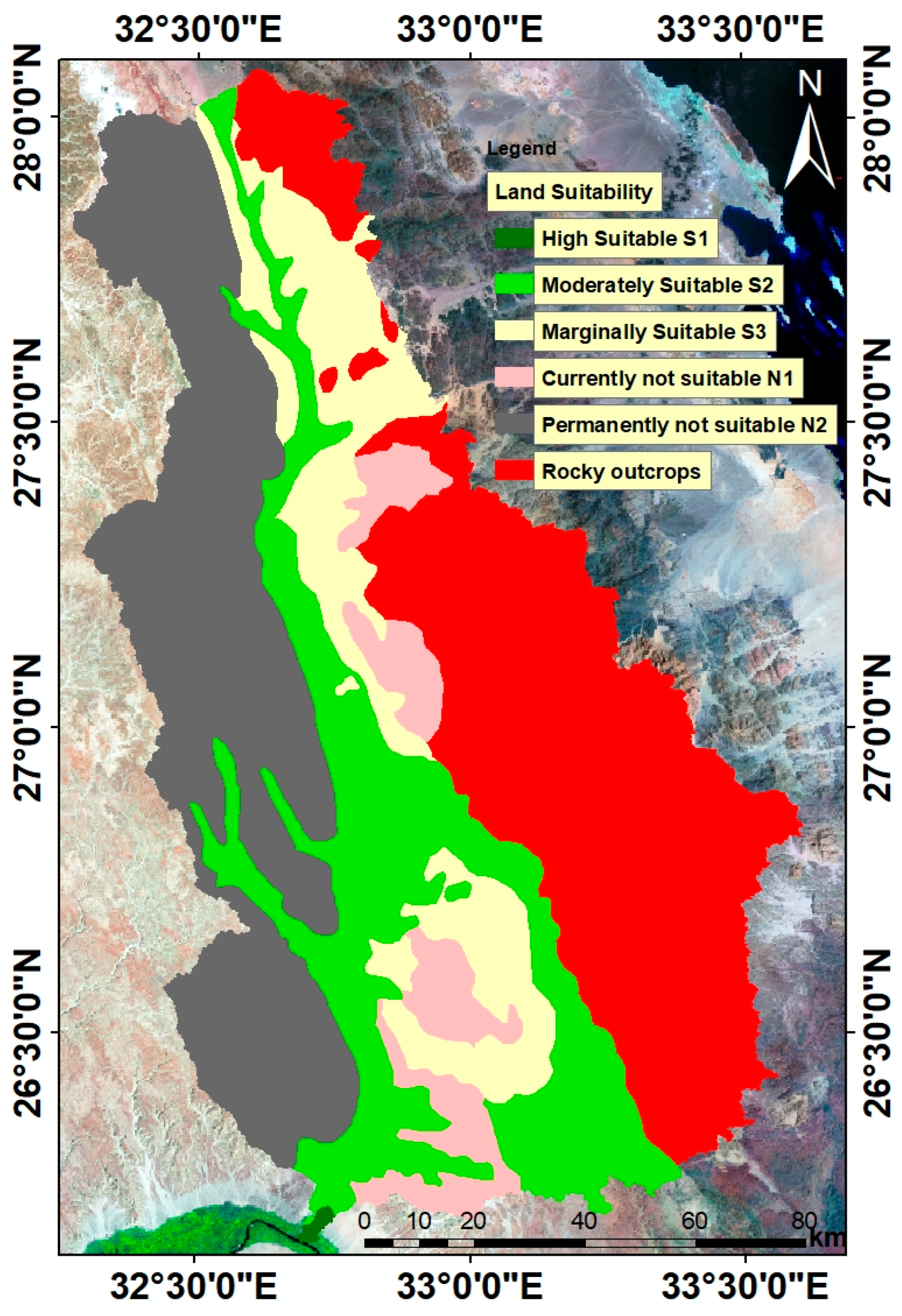
| Station Name (North to South) | Longitude | Latitude | Elevation (m) | Avg. Rainfall (mm/Year) |
|---|---|---|---|---|
| Hurghada | 570,350.1 | 3,003,248 | 169.83 | 7.57 |
| Kossir | 629,964.3 | 2,890,730 | 116.06 | 5.9 |
| Minya | 276,940.2 | 3,108,145 | 132.24 | 8 |
| Assuit | 302,625.7 | 2,993,532 | 188.11 | 3.49 |
| Sohag | 370,560.3 | 2,942,790 | 286.88 | 2.27 |
| Luxor | 469,890.7 | 2,838,066 | 236.03 | 2.75 |
| South valley Uni. | 75,023.05 | 2,897,857 | 282.6 | 3.09 |
| Classified Data | Reference Data | |||||||
| LULC Classes | Desert | Wadi Deposits | Agriculture | Buildings | Water | Total | Users’ Accuracy (%) | |
| Desert | 1912 | 48 | 21 | 1981 | 96.5% | |||
| Wadi deposits | 20 | 1880 | 57 | 5 | 20 | 1982 | 94.8% | |
| Agriculture | 56 | 19 | 1708 | 8 | 1791 | 95.3% | ||
| Buildings | 9 | 20 | 3 | 720 | 55 | 807 | 89% | |
| Water | 13 | 2 | 36 | 8 | 980 | 1039 | 94% | |
| Total | 2010 | 1969 | 1825 | 733 | 1063 | 7600 | ||
| Producer Accuracy (%) | 95% | 95.5% | 93% | 98% | 92% | |||
| Overall Accuracy: 94.7, Kappa Coefficient: 0.92 | ||||||||
| Thematic Layer | Map Rank | Map Weight | Classes | Infiltration Range | Rank | Capability Value |
|---|---|---|---|---|---|---|
| Geology | 2 | 2/18 = 0.11 | Wadi deposits | Very high | 4 | 0.4 |
| Pliocene | High | 3 | 0.3 | |||
| Sedimentary succession | Moderate | 2 | 0.2 | |||
| Basement rocks and Nile deposits | Low | 1 | 0.1 | |||
| Drainage density | 12 | 2/18 = 0.11 | 0.00000–0.0004 | Very high | 4 | 0.4 |
| 0.0004–0.0009 | High | 3 | 0.3 | |||
| 0.0009–0.00185 | Moderate | 2 | 0.2 | |||
| 0.00185–0.00332 | Low | 1 | 0.1 | |||
| Slope | 3 | 3/18 = 0.166 | 0–4 | Very high | 5 | 0.33 |
| 4–10 | High | 4 | 0.26 | |||
| 10–18 | Moderate | 3 | 0.2 | |||
| 18–30 | Low | 2 | 0.13 | |||
| 30–74 | Very low | 1 | 0.06 | |||
| Topography | 2 | 2/18 = 0.11 | 65–200 | Very high | 5 | 0.33 |
| 200–320 | High | 4 | 0.26 | |||
| 320–460 | Moderate | 3 | 0.2 | |||
| 460–950 | Low | 2 | 0.13 | |||
| 950–1867 | Very low | 1 | 0.06 | |||
| Soil | 2 | 2/18 = 0.11 | Sandy soil and gravel | Very high | 4 | 0.4 |
| Alluvial | High | 3 | 0.3 | |||
| Rocky sands with lime | Moderate | 2 | 0.2 | |||
| Hard rocks | Low | 1 | 0.1 | |||
| Rainfall | 1 | 1/18 = 0.05 | 2.9–4.2 | Low | 1 | 0.1 |
| 4.2–5.1 | Moderate | 2 | 0.2 | |||
| 5.1–6 | High | 3 | 0.3 | |||
| 6–7.3 | Very high | 4 | 0.4 | |||
| Lineament density | 2 | 4/18 = 0.11 | 0–000147 | Low | 1 | 0.1 |
| 0.000147–0.0004 | Moderate | 2 | 0.2 | |||
| 0.0004–0.00059 | High | 3 | 0.3 | |||
| 0.000598–0.001135 | Very high | 4 | 0.4 | |||
| LU/LC | 1 | 1/18 = 0.05 | Buildings | Very low | 1 | 0.1 |
| Agriculture | Low | 2 | 0.2 | |||
| Desert | Moderate | 3 | 0.3 | |||
| Water | High | 4 | 0.4 | |||
| Wadi deposits | Very high | 5 | 0.5 | |||
| Flow accumulation | 2 | 2/18 = 0.11 | <2 | Very high | 1 | 0.33 |
| 2–3 | High | 2 | 0.26 | |||
| 3–5 | Moderate | 3 | 0.2 | |||
| 5–6 | Low | 4 | 0.13 | |||
| >6 | Very low | 5 | 0.06 | |||
| Flow direction | 1 | 2/18 = 0.55 | <2 | Very high | 1 | 0.33 |
| 2–8 | Very high | 2 | 0.26 | |||
| 8–32 | High | 3 | 0.2 | |||
| 32–64 | Moderate | 4 | 0.13 | |||
| >64 | Low | 5 | 0.06 |
| Well No. | Latitude | Longitude | Well Depth (m) | Topographic Elevation (a.s.l) | Water Table (m) |
|---|---|---|---|---|---|
| 1 | 26.260 | 32.760 | 30 | 100 | 70 |
| 2 | 26.290 | 32.767 | 30 | 100 | 70 |
| 3 | 26.294 | 32.768 | 36 | 105 | 69 |
| 4 | 26.296 | 32.768 | 35 | 110 | 70 |
| 5 | 26.331 | 32.780 | 50 | 115 | 60 |
| 6 | 26.670 | 32.786 | 8 | 125 | 107 |
| 7 | 26.315 | 32.745 | 4 | 195 | 121 |
| 8 | 26.386 | 32.780 | 120 | 110 | 75 |
| 9 | 26.400 | 32.798 | 5 | 130 | 105 |
| 10 | 26.523 | 32.802 | 15 | 135 | 115 |
| 11 | 26.266 | 32.774 | 15 | 165 | 120 |
| 12 | 26.78 | 32.783 | 80 | 115 | 110 |
| 13 | 26.618 | 32.788 | 5 | 200 | 36 |
| 14 | 26.810 | 33.463 | 12 | 647 | 584 |
| 15 | 26.265 | 33.458 | 16 | 705 | 109 |
| 16 | 26.404 | 32.788 | 10 | 115 | 130 |
| 17 | 26.257 | 32.761 | 12 | 600 | 75 |
Disclaimer/Publisher’s Note: The statements, opinions and data contained in all publications are solely those of the individual author(s) and contributor(s) and not of MDPI and/or the editor(s). MDPI and/or the editor(s) disclaim responsibility for any injury to people or property resulting from any ideas, methods, instructions or products referred to in the content. |
© 2023 by the authors. Licensee MDPI, Basel, Switzerland. This article is an open access article distributed under the terms and conditions of the Creative Commons Attribution (CC BY) license (https://creativecommons.org/licenses/by/4.0/).
Share and Cite
Megahed, H.A.; Farrag, A.E.-H.A.; Mohamed, A.A.; D’Antonio, P.; Scopa, A.; AbdelRahman, M.A.E. Groundwater Recharge Potentiality Mapping in Wadi Qena, Eastern Desert Basins of Egypt for Sustainable Agriculture Base Using Geomatics Approaches. Hydrology 2023, 10, 237. https://doi.org/10.3390/hydrology10120237
Megahed HA, Farrag AE-HA, Mohamed AA, D’Antonio P, Scopa A, AbdelRahman MAE. Groundwater Recharge Potentiality Mapping in Wadi Qena, Eastern Desert Basins of Egypt for Sustainable Agriculture Base Using Geomatics Approaches. Hydrology. 2023; 10(12):237. https://doi.org/10.3390/hydrology10120237
Chicago/Turabian StyleMegahed, Hanaa A., Abd El-Hay A. Farrag, Amira A. Mohamed, Paola D’Antonio, Antonio Scopa, and Mohamed A. E. AbdelRahman. 2023. "Groundwater Recharge Potentiality Mapping in Wadi Qena, Eastern Desert Basins of Egypt for Sustainable Agriculture Base Using Geomatics Approaches" Hydrology 10, no. 12: 237. https://doi.org/10.3390/hydrology10120237
APA StyleMegahed, H. A., Farrag, A. E.-H. A., Mohamed, A. A., D’Antonio, P., Scopa, A., & AbdelRahman, M. A. E. (2023). Groundwater Recharge Potentiality Mapping in Wadi Qena, Eastern Desert Basins of Egypt for Sustainable Agriculture Base Using Geomatics Approaches. Hydrology, 10(12), 237. https://doi.org/10.3390/hydrology10120237








